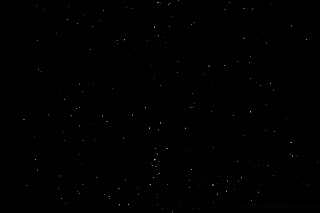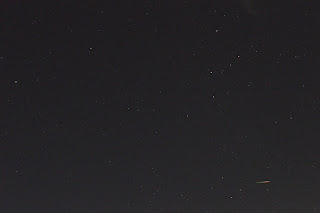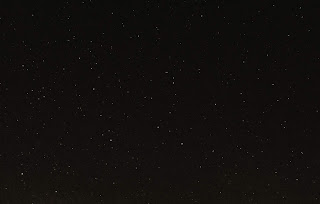August 26th 2225 GMT
I did a half-hour watch for Perseid meteors and took some constellation shots of the region hoping to catch one.
I saw one of about magnitude 2 travelling north east at 2243 GMT.
I caught a very short trail in this shot but it was definitely not a Perseid.
I combined 23 frames to obtain this shot of Cepheus.
I caught the constellation of Andromeda well but to remove the background glow, I lost the Andromeda Galaxy (M31).
August 24th 0000 GMT
I watched for Perseids for half an hour and took some photos of the area. I didn't think I caught any on camera but I saw four, three of which were Perseids. The brightest was a magnitude 1 sporadic. It was officially the last day of the shower but I was quite pleased with the ones I saw.
The first 3 frames stacked nicely for Perseus.
Frames 4 to 40 produced a nice Cassiopeia.
The final set of shots caught Cygnus nicely,
I finished with the Moon with my DSLR at 300mm focal length, ISO 100 and 1/200 second exposure.
August 23rd 2140 GMT
I looked in vain for a last minute Perseid. Conditions were rather poor, so I did not see any. I took some frames around Cassiopeia and Cygnus, just in case. They were ruined by poor focus and cloud but the first "sighter" showed Aquila, Delphinus and Sagitta.
April 23rd 1320 GMT
The Sun looked quiet, even in hydrogen alpha light but I
took a few shots anyway.
August 20th 0400 GMT
It was dawn but the waning gibbous moon was high in the south west. I took some frames at 300mm focal length, ISO 100 and 1/400 second exposure.
August 14th 0115 GMT
Most of the sky was covered with cloud. I took some frames of the Moon at ISO 100, 300mm focal length and 1/1000 second exposure. Unfortunately, I could not extract anything useful from the frames.
August 13th 0100 GMT
Although I was well tired by this time, I went out for 20
minutes. It was much more clear and I aimed my cameras west of the radiant. I
saw one bright meteor of about zero magnitude flash towards Taurus. I was
feeling rather philosophical, wondering how many more times I would see the
Perseid shower before I die. It was not just how many years I would live but
also weather.
OK here's Perseus again. No meteors.
August 13th 2300 GMT
Conditions had cleared but I still needed to move the
cameras to catch what clear sky was available in the east and north east. I saw
7 Perseid meteors of which four were brighter than Jupiter with the brightest
being about magnitude -6. Without having any evidence, that estimate equalled a
sporadic meteor that I had seen in Dusseldorf in 2013. The bright ones came in
quick succession between 2330 GMT and 2336 GMT.
A quick look through the camera images showed that I caught
one fireball on camera and one about magnitude 1 that I did not spot visually.
I created a photo from the first set of frames of Perseus.
I caught a Perseid near Cassiopeia.
When I moved to Ursa Minor, I did not catch any meteors but got one of my better shots of the constellation.
Similar for Cassiopeia.
Back to Perseus.
I finished with no more meteors and Perseus.
I found a bright fireball on the images from the antique Konica Minolta.
August 12th 2100 GMT
I went out armed with my Nikon D3200 at my meteor detecting
setting of 16mm focal length, ISO 6400 and 8 seconds exposure. I used my
antique Konica Minolta DSLR at 18mm focal length, ISO 3200 (all it goes up
to!!) and 8 seconds exposure. The plan was to have one camera taking photos
while the other developed the photo just taken. Once I got the rhythm, I was
getting only short gaps between shots.
Unfortunately, I did not see any meteors and it clouded over
completely by 2125 GMT. Rain soon followed! I could not use any images for constellation shots, due to twilight and cloud.
August 12th 1410 GMT
The Sun was quiet in hydrogen alpha light but I was at home and there was a period of clear sky between the showers. I took a few shots with my PST and DSLR just in case. I actually caught some minor detail.
August 10th 2120 GMT
The moon was waxing gibbous and I took some frames with my DSLR at 300mm focal length, ISO 400 and 1/4000 second exposure.
I then tried a video recording of the Perseid shower by aiming my camera at Cassiopeia, again! It failed miserably!
August 7th 2100 GMT
I had a short session looking for Perseid meteors. I saw a bight (mag 0) one at 2117GMT but did not catch it on camera. Early indications were that I caught a few stars. I stacked the best 20 images to get another image of Cassiopeia.
August 7th 2015 GMT
The Moon was above a cloudless horizon and I took a few frames at the same settings as the evening before.
Aug 6th 2100 GMT
I took some frames of the Moon with my DSLR at 300mm focal length, ISO 100 and 1/400 second exposure.Aug 3rd 2240 GMT
I had been checking the sky from early evening and, finally, there were some clear patches. As you might expect, I ignored Jupiter and Saturn and went for meteors. I saw a bright one at 2255 GMT flash below Cassiopeia.
However, as the cloud was moving, I aimed my camera in various directions to catch the clearer bits of sky. I used 16mm focal length, ISO 6400 and 8 seconds exposure and too some dark frames after I finished the shoot.
I did not see any Perseids but caught a sporadic meteor near Hercules.
The second showed Cassiopeia.
The third showed Hercules.
The fourth showed Cygnus and Lyra, with Sagltta and the Coathanger asterism near the bottom.
The fifth was aimed at Pegasus but was too near the horizon and a streetlight.
The sixth caught Ursa Minor.
The seventh and final shot was another of Cassiopeia.
The third showed Hercules.
The fourth showed Cygnus and Lyra, with Sagltta and the Coathanger asterism near the bottom.
The fifth was aimed at Pegasus but was too near the horizon and a streetlight.
The sixth caught Ursa Minor.
The seventh and final shot was another of Cassiopeia.
































No comments:
Post a Comment